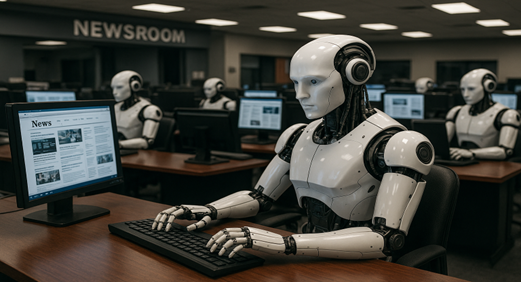AI-Powered Journalism: Can Robots Replace Reporters?
- Shilpi Mondal

- Oct 16
- 3 min read
SHILPI MONDAL| DATE: MAY 30 ,2025

Introduction
The rise of artificial intelligence (AI) has sparked a heated debate in journalism: Can robots replace reporters? While AI-powered tools are already drafting news stories, transcribing interviews, and even generating synthetic news anchors, the question remains whether they can truly replicate the depth, ethics, and creativity of human journalism.
This blog explores the current state of AI in journalism, its benefits, limitations, and whether robots are poised to take over newsrooms—or simply become indispensable assistants.
The Rise of Robo-Journalism

AI is no longer a futuristic concept—it’s already reshaping news production. Here’s how:
Automated News Writing
AI algorithms like Wordsmith and GPT-4 can generate articles in seconds, particularly for data-heavy topics such as sports, finance, and weather.
In 2016, Wordsmith alone produced 1.5 billion news stories, rivaling human output.
Bloomberg uses AI to create 25% of its content, primarily for market updates and earnings reports.
AI News Anchors & Virtual Reporters
Nat, an AI news anchor from Mexico’s Grupo Formula, delivers entertainment news tailored to younger audiences.
China’s Xinhua News Agency introduced Jia Jia, a humanoid robot journalist, though her capabilities remain limited.
Swiss radio station Couleur 3 experimented with AI-generated voices for 13 hours, testing audience reactions (spoiler: listeners missed human hosts).
Efficiency & Cost-Cutting
AI speeds up transcription, fact-checking, and SEO optimization, freeing journalists for investigative work.
Newsrooms save costs by automating routine tasks, reducing reliance on manual labor.
The Human Edge: Why Robots Can’t Fully Replace Reporters
Despite AI’s advancements, journalism remains a deeply human craft. Here’s why:
Lack of Creativity & Emotional Depth
AI can mimic writing styles but struggles with nuanced storytelling, humor, and investigative depth.
As one expert noted, “AI broadcasters have no empathy… they can only read facts without passion”.

Ethical & Bias Concerns
AI models can hallucinate facts or replicate biases from training data, risking misinformation.
Human oversight is crucial for fact-checking, ethical judgment, and accountability.
The Irreplaceable Human Connection
AI can’t conduct in-depth interviews, sense emotional undertones, or report from war zones like human journalists.
As one study found, audiences prefer human presenters for trust and relatability.
The Future: Collaboration, Not Replacement
Rather than replacing journalists, AI is evolving into a powerful collaborator:
AI as an Assistant, Not a Competitor
73% of newsrooms use AI for writing, 68% for data analysis, and 62% for personalized content.
Tools like Google’s Pinpoint help journalists uncover hidden patterns in large datasets.
Hybrid Journalism: The Best of Both Worlds
AI handles breaking news, data reports, and translations, while humans focus on investigations, opinion pieces, and storytelling.
The Washington Post uses AI-generated audio for articles, but human editors ensure quality.
The Need for AI-Educated Journalists
Journalists must learn prompt engineering, AI ethics, and fact-checking to work alongside AI.Universities like UBC now teach students to critique AI-generated content.
Conclusion: Will Robots Take Over?
The answer is no—but they will transform journalism. AI excels at speed, data processing, and automation, but human reporters bring creativity, ethics, and emotional intelligence that machines can’t replicate.
The future belongs to AI-augmented journalism, where robots handle the grunt work, and humans focus on what they do best: telling compelling, truthful, and impactful stories.
So, will AI replace reporters? Not entirely—but those who embrace it will thrive.
Citations:
Miroshnichenko, A. (2018). AI to Bypass Creativity. Will Robots Replace Journalists? (The Answer Is “Yes”). Information, 9(7), 183. https://doi.org/10.3390/info9070183
Deepbrain AI | Evolving AI Journalism. . . Will reporters disappear? (n.d.). AI STUDIO. https://www.aistudios.com/blog/evolving-ai-journalism
Conmy, S. (2024, August 16). Robots replacing reporters and the future of journalism. Contenseo | Licence Content From the World’s Top Creators. https://contenseo.com/robots-replacing-reporters-and-the-future-of-journalism/
Fuchs, M. (2021, December 2). Robo-reporters: The end of the story for journalism? St. Gallen Symposium. https://symposium.org/robo-reporters-the-end-of-the-story-for-journalism/
When the robots take over: The future of AI and journalism. (n.d.). https://signalhfx.ca/when-the-robots-take-over-the-future-of-ai-and-journalism/
Image Citations:
Alison Lancaster, CEO, Pressat. (2025, May 8). The machines are coming for the newsroom: Journalists warn of an AI takeover. Latest Press Releases | PressGo | Journalism.co.uk. https://www.journalism.co.uk/press-releases/the-machines-are-coming-for-the-newsroom-journalists-warn-of-an-ai-takeover/s66/a1244457/
Agrawal, N. (2024, April 1). AI anchors promise a future where robots deliver news - Cyber journalist. Cyber Journalist. https://www.cyberjournalist.net/2024/04/01/ai-anchors-promise-a-future-where-robots-deliver-news/
Enio-Ia. (2024, March 18). Download Artificial intelligence, robot, Technology. Royalty-Free Stock Illustration Image. Pixabay. https://pixabay.com/illustrations/artificial-intelligence-robot-8635352/





Comments